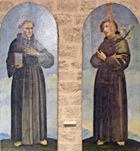The Palazzo dei Canonici (1552) now houses the Pinacoteca Comunale, which was opened in 1994.
[A bell cast in 1209 for Santa Maria Maggiore]
Madonna with Child (ca. 1200)
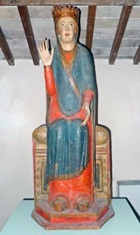
Madonna and Child (ca. 1300)
Crucified Christ (early 14th century)
This painted wooden figure of Christ was rediscovered in 1974 in a store room in Santa Maria Maggiore. It has moveable arms, which would have allowed it to be removed from a cross and taken in procession at Easter. [This was not displayed in 2009]
Diptych (1391)
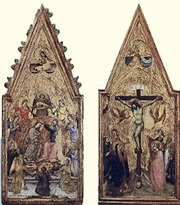
The inscription on this portable diptych records its commission by Guadagno Vagnolli Cole from Cola Petruccioli in 1391. The commissioner was the prior of Santa Maria Maggiore from 1380 until 1396, when Bishop Lorenzo Corvino of Spoleto deposed him for reasons unknown. The diptych depicts:
-
✴the Crucifixion with:
-
•the Virgin and SS John the Baptist and Mary Magdalene on the left;
-
•SS John the Evangelist, Nicholas of Bari and Catherine of Alexandria on the right; and
-
•the Archangel Gabriel above; and
-
✴the Coronation of the Virgin with musical angels, and the Virgin Annunciate above.
Processional Cross (1398)
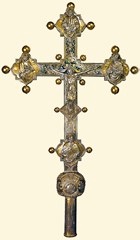
Detached frescoes (14th-16th centuries)
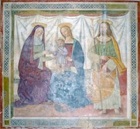
-
✴the Madonna and Child (mid 14th century); and
-
✴four frescoes from the early 16th century:
-
•the Madonna and Child ;
-
•the Madonna and Child with SS Anne and James (illustrated here);
-
•the Madonna and Child with four tiny kneeling donors; and
-
•the Annunciation.
Panels from a triptych (early 15th century)
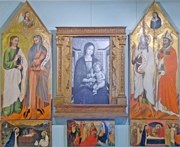
These panels came from a polyptych that was probably originally commissioned for the high altar of Santa Maria Maggiore. It was dismembered at an unknown time and its panels were then used on individual altars. This central panel and one of the predella panels were stolen in 1970, but they were fortunately recovered in 1992. Most of the panels are now in the Pinacoteca, although the central panel here is replaced by a photograph: the original is in the Cappella dei Canonici, Santa Maria Maggiore.
Following a recent restoration, the side panels and predella panels have been attributed to the Maestro dell’ Assunta di Amelia:
-
✴The side panels depict:
-
•St John the Evangelist and Isaiah, with the Archangel Gabriel above (on the left);
-
•SS John the Baptist and Nicholas of Bari, with the Virgin Annunciate above (on the right).
-
Their restoration revealed tiny kneeling donors that had been over-painted.
-
✴The predella panels depict scenes from the early life of Christ:
-
•the nativity;
-
•the adoration of the Magi; and
-
•the presentation of Christ at the Temple.
The central panel, which depicts the Madonna and Child enthroned, was presumably also the work of the Maestro dell’ Assunta di Amelia. However, it was extensively repainted in ca. 1500, although the throne seems to be largely original. Its present frame was probably executed at the time of the over-painting, which has been attributed to Andrea d’ Assisi, l’ Ingegno (see the link below).
Processional banner (15th century)
This double-sided banner, which came from the Oratorio di Santa Croce, is attributed to Pietro di Giovanni Mazzaforte or his workshop. It belonged to the Compagnia della Croce and the nearby Confraternita della Misercordia, which had merged in 1386.
-
✴The Madonna della Misericordia on the front of the banner is badly damaged.
-
✴The reverse shows the miracle of the apparition of a cross above Spello, which led to the foundation of the Compagnia della Croce.
This foundation miracle occurred (according to tradition) in 1346, when the factions of Spello fought a battle under the nearby Torre dell’ Olmo (demolished in 1457). This conflict ended abruptly when a cross of fire appeared in the sky, and the erstwhile enemies made peace. (In later versions of the legend, the fight occurred at the instigation of a vicious old lady called Gabrina.) In the scene here, figures of Christ and the Virgin flank the Torre dell’ Olmo, looking up at a cross held by angels. Two young men at the foot of the tower (presumably erstwhile combatants) also look up, amazed at the spectacle.
[This banner was in restoration in 2009]
Crucifixion (15th century)
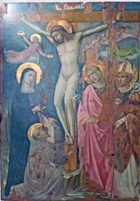
Madonna and Child with saints (1503?)
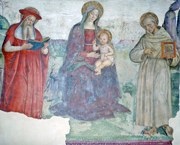
This detached fresco of the Madonna and Child with SS Jerome and Bernardino of Siena is from the ex-Oratorio di San Bernardino. It was detached early in the 20th century, and the date 1503 was probably inscribed at that point. Some scholars regard this as spurious.
This fresco, along with the repainting of the panel of the Madonna and Child (above) are attributed to Andrea d’ Assisi, l’ Ingegno. It is possible that he worked with Pintoricchio on the frescoes (1501) of the Cappella Bella, Santa Maria Maggiore.
Madonna of the Rosary (late 16th century)
This panel, which is attributed to Ascensidonio Spacca, il Fantino, was documented following the Apostolic Visit of 1610, when it was on the Altare del Rosario, to the right of the entrance. It was removed when the church was re-modeled in 1644-90. It depicts SS Dominic, Peter Martyr and Catherine of Siena and another female Dominican saint receiving rosaries from the Madonna and Child while, below, a pope and a group of nobles kneel in front of the choir of a church that is clearly identifiable as Santa Maria Maggiore. A small coat of arms on the cope of the papal figure identify him as the Dominican Pope Pius V, who instituted the feast of the rosary after the Battle of Lepanto (1571).
This panel was probably executed after the formation of the Society of the Rosary at Santa Maria Maggiore in 1590. The description of the panel in 1610 identifies the lay people depicted in it as members of this society. This group includes two small children and a baby in the arms of its nurse.
[This panel was not displayed in 2009]
Panels by Marcantonio Grecchi
The following altarpieces by or attributed to Marcantonio Grecchi were (unless otherwise stated) probably removed from Santa Maria Maggiore during the re-modeling of 1644:
-
✴Madonna and Child in glory with saints (1603)
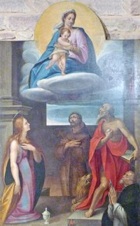
-
This altarpiece, which is signed and dated by inscription, depicts the Madonna and Child with SS Mary Magdalene, Francis, Jerome and Raymond of Peñafort (a Dominican who died in 1275 and was canonised by Pope Clement VIII in 1601).
-
-
-
-
-
-
-
St Antony Abbot enthroned (1604)
-
This altarpiece, which is dated by inscription and attributed to Marcantonio Grecchi, contains a portrait of the unknown donor.
-
✴St Felix Altarpiece (ca. 1610)
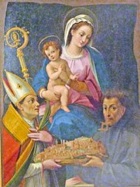
-
This altarpiece, which depicts the Madonna and Child with St Felix and the Blessed Andrew Caccioli, is attributed to Marcantonio Grecchi. It is probably the altarpiece that was removed from the Altare di San Felice in 1930. It provides evidence that both of these saints were considered to be patrons of Spello in the early 17th century.
-
-
-
✴St Felix with angels (1617)
-
This altarpiece, which is signed and dated by inscription, depicts the standing St Felix with two angels, one of whom holds a cityscape of Spello.
-
✴Madonna of Constantinople with saints (early 17th century)
-
This altarpiece, which is attributed to Marcantonio Grecchi, depicts the Madonna of Constantinople with St Michael (who holds the scales of justice in his left hand points the sword in his right hand at a dragon) and St Francis.
SS Bernardino of Siena and Antony of Padua (17th century)
Death of St Joseph (ca. 1700)
This altarpiece was recorded in San Michele Arcangelo in 1896, with an attribution to Carlo Lamparelli. [It was not displayed in 2009]
Reliquary of St Felix (1788)
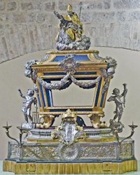
The relic in question, which came from San Felice di Giano, was probably housed in this reliquary above the Altare di San Felice in Santa Maria Maggiore. Its base contains holes for poles so that the relic could be taken in procession.
The relic was moved to another reliquary that is still housed there: this might have occurred in 1883, when the reliquary here was restored.






